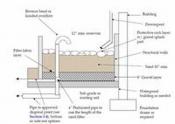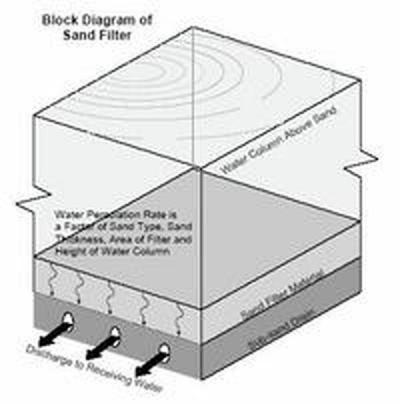Sand Filters
Sand filters, like planter boxes, are structural reservoirs that filter pollutants from stormwater and slow water runoff. Infiltration sand filters allow water to infiltrate through the sand and into the ground. Flow through sand filters include the use of a waterproof lining, and include an overflow to an approved stormwater conveyance system.
Specifications
The minimum width is 18 inches, with at least 12 inches of storage depth and up to 6 feet storage depth, and filter slopes must be less than 0.5%. Minimum setback from property lines is 5 feet, unless the facility is less than 30 inches high. The sand layer shall be a minimum of 18 inches deep of clean medium to fine sand with no organic material, underlain by filter fabric and an 8” layer of ½” to 2” gravel. Side slopes will be a maximum of 4:1. Any shape sand bed may be used, provided that adequate treatment surface is provided.
An energy dissipater must be provided for water entering from a point source (pipe). If stormwater with a high concentration of particles will be treated, treating water in a sediment basin prior to discharge into the sand filter may help extend the life of the sand filter.
A high-flow overflow must be provided to an approved conveyance system. Sand filters shall be designed to pond water for less than 4 hours after each storm event.
Filter structural walls must not be made out of material that can leach toxic chemicals and contaminate stormwater.
Infiltration sand filters
Infiltration sand filters are appropriate for soils with a minimum infiltration rate of 2 inches per hour. Infiltration filters must be set back at least 10 feet from building structures, to prevent damage to the foundation.

Flow-through filters
Flow-through filters are appropriate for all soil types, and incorporate the use of an appropriately designed waterproof membrane. Flow-through filters may be used next to foundation walls, and the structural walls can be incorporated into the building foundation plans. 4 inch perforated pipes must be used under the gravel layer, and must run the length of the sand filter.
Planting Specifications
Plantings are not required for sand filters, but potted plants may be submerged in the sand filter for aesthetic purposes. No topsoil may be added for optional plantings. Weeds and organic debris should be removed from the sand to ensure proper functioning.

Maintenance Requirements
- Debris, including weeds, leaves, and sediment shall be removed at least quarterly, or if function is compromised
- The inlet shall be maintained so as to allow water to uniformly enter the sand filter, without causing erosion
- Blockages that prevent the filter from properly treating stormwater shall be identified and corrected
- Nuisance or prohibited vegetation (as listed in the City of Portland Native Plants List) shall be removed
Sand Filter Locations in Sandy
None at this time
Resources Used
- City of Gresham Department of Environmental Services Stormwater Division. Water Quality Manual. Summer 2003.
- City of Oregon City. City of Oregon City Stormwater and Grading Design Standard; Chapter 5 of City Code.
- City of Portland Bureau of Environmental Services. Stormwater Management Manual. July 1, 1999; Revised 2004
- Clean Water Services. Design and Construction Standards for Sanitary Sewer and Surface Water Management. March 2004.
- Additional information and resources are available on the City of Portland Bureau of Environmental Services web page

